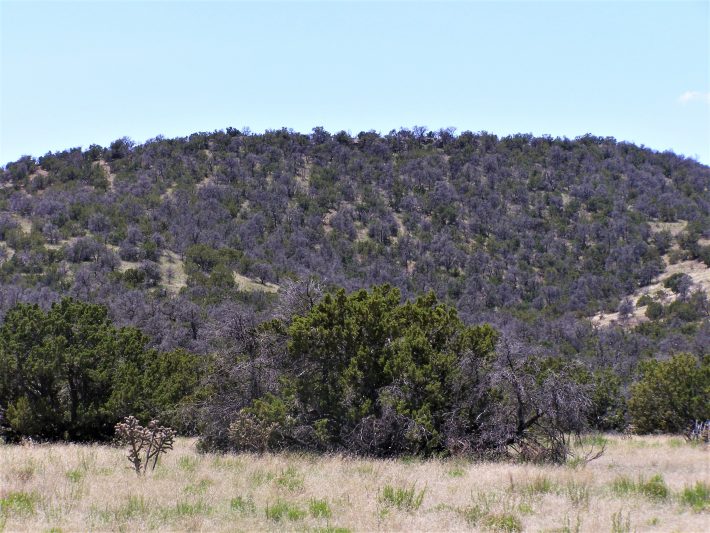It takes a microclimate to raise a pinyon tree
Colorado State University press release
With all the discussion about global climate change effects, new research published in Journal of Ecology shows that another kind of climate is an important factor in regional pinyon pine tree recovery after drought events – the microclimate.

Microclimates are localized climates found within a larger one, like that of a cool canyon in the desert Southwest. These occur because of local differences intopography and existing vegetation that control temperature, wind patterns, humidity, and available water. These physical subtleties create smaller ground level environments called microsites, which are often necessary to support individual life forms like a pinyon pine tree.
Pinyon pine trees are integral in processes that control water and energy fluctuations across the Southwest. The trees also store large amounts of carbon for the region. Pinyon pine has long provided food —pine nuts, used to make pesto — shelter and other products for people and animals.
“Recent droughts have resulted in widespread pinyon pine mortality throughout much of the southwestern U.S.,” said Miranda Redmond, CSU assistant professor and lead author of the study. “Our team was really interested in whether or not these woodlands were going to come back and how local environmental factors influence their recovery.”
Redmond collaborated on this research with Professor Peter Weisberg of University of Nevada Reno, Research Professor Neil Cobb of Northern Arizona University, and Assistant Research Professor Michael Clifford of the Desert Research Institute.
In the study, they examined how the next generation of pinyon pine trees were recovering after a severe drought in 2002-2004 caused widespread mortality in adult trees. The team determined that pinyon pine resilience varied across the landscape because microclimates must meet specific conditions to promote young seedling regeneration and juvenile tree survivorship.
Microclimate criteria
The study sites were spread out across 5,000 square miles of pinyon-juniper woodlands in Colorado, New Mexico and Arizona, to capture the wide range of elevation and soil gradients these trees take root in. Sampling across a large area was necessary to determine microclimate zones best suited for recovery in these woodlands that occupy over 50,000 square miles of the Four Corners area alone.
“The good news is that while there were some areas with minimal regeneration, there were also areas that had a lot of pinyon pine regeneration,” Redmond said. “These areas were generally cooler and wetter, with higher tree cover.”
Researchers identified four factors that determine the potential for pinyon pine populations to recover after a period of extended drought:
- Cooler and wetter localized climates with greater soil water capacity
- Tree canopy cover providing shaded microsite conditions
- Abundant older juvenile trees that had survived the drought
- Mature pinyon trees with high seed production that also survived the drought
These simultaneous demands seem impossible to meet after high tree mortality, but Redmond said the fact that areas still meet these criteria means many young trees have a fighting chance to re-establish woodlands and escape their forbears more dismal fate.
Microsite competition
Pinyon pine trees depend on microclimates to prime ground-level microsites from which they grow. The common denominator that appears to guide the presence or absence of resilience at the individual tree level was shade.
Shaded microsite areas found below mature pinyon pine canopies (or overstory) have lower soil temperature and retain higher soil moisture content, both of which are fundamental to new tree regeneration. The amount of shade was greatly reduced in areas that experienced the highest pinyon pine casualties. Redmond’s team compared pinyon seedlings and young trees from various areas to see how more sunlight affected their microsites and found an interesting result.
Shade appeared to perform another indirect function. These slightly darker and cooler areas kept sun-loving grasses from extending their reach into suitable pinyon regeneration sites. Even though pinyon pine trees are generally well adapted to the Southwest’s dry heat, grasses are even better, making them one potential threat to the pinyon pine kingdom.
“Grasses appear to compete with pinyon juveniles, suggesting that overstory tree mortality can adversely affect pinyon recruitment if these microsites experience a huge infiltration of grass.” Redmond said.
Another rival could be the co-dominant tree in pinyon-juniper ecosystems. In general, juniper trees have resisted drought better than pinyon pine, and research has documented juniper regeneration in grassy areas. A lack of this adaptation may eventually become a disadvantage for pinyon pine trees, but for now existing microsites provide both the offensive and defensive tactics needed to defend their ground from encroaching grasses.
An uncertain future
The recent drought didn’t affect all pinyon pine trees equally in the Southwest. This variability from site to site and state to state inspired the research team to conduct this study on a much larger scale. The resilience indicators they identified narrow down the region to smaller locales that are still currently sustainable.
Their findings offer an underlying explanation for scientific claims that this recent drought was just a taste of what the warming climate may do to pinyon-juniper ecosystems. It’s difficult to predict if or how fast these resilience areas could shrink as the century progresses. Redmond said current warming trends could reduce the number of areas with microclimates favorable for future pinyon pine recovery, not if but when the next drought happens.
“Because of recent changes in climate and projected changes in climate, these Southwest ecosystems are likely going to experience some really severe vegetation shifts,” she said
The possibility for drought resilience across the Southwest may disappear if that’s the case.
Read the full article (freely available for a limited time):
Redmond MD, Weisberg PJ, Cobb NS, Clifford MJ. Woodland resilience to regional drought: Dominant controls on tree regeneration following overstorey mortality. J Ecol. 2017;00:1–15. DOI: 10.1111/1365-2745.12880
Media contact:
Mary Guiden, Communications Coordinator, Colorado State University; Email: mary.guiden@colostate.edu, Tel: +1 (0)970 491 6892
Like what we stand for?
Support our mission and help develop the next generation of ecologists by donating to the British Ecological Society.